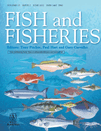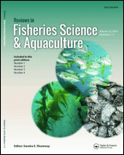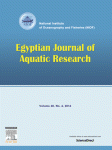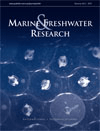
FISH AND FISHERIES
Scope & Guideline
Navigating the complexities of fish and fisheries science.
Introduction
Aims and Scopes
- Ecological and Biological Research:
The journal publishes studies exploring fish biology, including growth, reproduction, nutrition, and behavior, contributing to a deeper understanding of fish species in both wild and farmed environments. - Aquaculture Innovations:
Research on various aquaculture practices, including the use of alternative feeds, breeding programs, and sustainable farming techniques, is a core focus, enhancing productivity and sustainability in fish farming. - Fisheries Management and Policy:
The journal addresses issues related to fisheries management, including stock assessments, population dynamics, and the socio-economic impacts of fishing practices, providing insights for policymakers. - Environmental Impact Studies:
Research assessing the effects of environmental factors on fish populations, including climate change, pollution, and habitat degradation, plays a significant role in understanding and mitigating threats to aquatic ecosystems. - Technological Advances:
The journal covers advancements in technologies related to fishery science, such as genetic analysis, remote sensing, and modeling tools, which are crucial for contemporary fisheries research.
Trending and Emerging
- Sustainable Aquaculture Practices:
Research focusing on sustainable aquaculture practices, such as biofloc technology and integrated multi-trophic aquaculture, is gaining traction as the industry seeks to minimize environmental impacts. - Climate Change Impacts on Fisheries:
There is an increasing emphasis on understanding how climate change affects fish populations, habitats, and fisheries management, reflecting global concerns about environmental change. - Nutritional and Health Aspects of Fish Farming:
Studies exploring the nutritional requirements and health management of farmed fish are trending, especially regarding alternative feeds and disease management strategies. - Socio-economic Factors in Fisheries:
Research examining the socio-economic dimensions of fisheries, including the impacts of fishing on local communities and livelihoods, is emerging as a critical area of inquiry. - Technological Integration in Fisheries Research:
The use of advanced technologies such as GIS, remote sensing, and molecular techniques is on the rise, indicating a trend towards more precise and data-driven approaches to fisheries research.
Declining or Waning
- Traditional Capture Fisheries:
Research focusing solely on traditional capture fisheries seems to be declining, possibly due to increasing emphasis on aquaculture and sustainability practices. - Basic Taxonomic Studies:
Although essential, the frequency of papers dedicated to basic taxonomic studies may be waning as the field shifts towards applied research with immediate implications for management and conservation. - Static Aquaculture Systems:
There is a noticeable decrease in studies centered around static aquaculture systems, with a growing trend towards dynamic and integrated systems that promote sustainability and resource efficiency.
Similar Journals

REVIEWS IN FISH BIOLOGY AND FISHERIES
Exploring the intricacies of fish biology and sustainable fisheries.Reviews in Fish Biology and Fisheries, published by Springer, is a prestigious journal dedicated to advancing our understanding of fish biology and the principles underpinning fisheries science. With an impact factor reflective of its high citation rate and its recognition as a Q1 category journal in Aquatic Science, it ranks impressively at #9 out of 247 in the Scopus database, placing it within the top 4% of its field. Established in 1991, this journal serves as a crucial platform for researchers, professionals, and students alike, offering comprehensive reviews and insights that foster innovation and collaboration in aquatic research. Although it is not available as an open-access publication, its rigorous peer-review process ensures the dissemination of quality research that informs policy and practices in fisheries management globally. With a diverse range of topics covered, the journal is an essential resource for anyone aiming to deepen their knowledge and impact in the dynamic fields of fish biology and fisheries.

INDIAN JOURNAL OF FISHERIES
Advancing aquatic science for sustainable fisheries.Welcome to the Indian Journal of Fisheries, an esteemed publication of the Central Marine Fisheries Research Institute, dedicated to advancing the field of aquatic sciences. Established in 1974, this journal serves as a crucial platform for researchers, professionals, and students interested in the dynamics of fishery research within the Indian context and beyond. With an impact factor highlighting its rigorous peer-review standards, the journal publishes research that significantly contributes to the understanding of fisheries management, conservation, and sustainable practices. Although currently categorized in Q4 for Aquatic Science (2023) and ranked #215 out of 247 in Scopus, its increasing visibility demonstrates the journal's dedication to enriching the scientific discourse surrounding aquatic ecosystems. Located in Kochi, India, and published intermittently from 1977 to 2024, it seeks to bridge knowledge gaps while promoting innovative methodologies in fishery sciences. While not an open-access journal, it fosters a vital exchange of scholarly work that informs fishing practices, policy, and ecological considerations vital to both national and global fisheries. Join us in exploring the intricate world of fisheries through our comprehensive collection of research articles, reviews, and case studies.

Reviews in Fisheries Science & Aquaculture
Fostering innovation in fisheries science and aquaculture.Reviews in Fisheries Science & Aquaculture is a leading peer-reviewed journal published by Taylor & Francis Inc, dedicated to advancing the understanding and sustainable management of aquatic ecosystems. With an impressive impact factor reflecting its high citation rates, this journal categorizes within Q1 in Aquatic Science, Q1 in Ecology, Evolution, Behavior and Systematics, and Q1 in Management, Monitoring, Policy and Law, making it an essential resource for researchers and professionals in these disciplines. Operating from the United Kingdom and accessible through open access options, the journal facilitates a wide dissemination of research findings, fostering innovation and collaboration among those committed to fishery science and aquaculture. As of 2023, it ranks remarkably within the 99th percentile across several Scopus categories, underscoring its pivotal role in shaping future research and policy. The journal has been converging insightful studies since its inception in 2014, and it continues to be an indispensable platform for scholars aiming to contribute to the critical dialogues surrounding aquatic resource management and conservation.

ICHTHYOLOGICAL RESEARCH
Unveiling the secrets of fish ecology and habitats.Ichthyological Research is a prominent journal in the field of ichthyology, focusing on the biology, ecology, and conservation of fish species and their habitats. Published by Springer Japan KK, this journal has been a significant contributor to aquatic research since its inception in 1996 and will continue to disseminate cutting-edge findings through 2024. With an Impact Factor that places it within Q2 of the Ecology, Evolution, Behavior, and Systematics category, it ranks #318 out of 721 in Scopus, situating it in the 55th percentile of its field. This journal serves as a valuable resource for researchers, professionals, and students, offering open access to vital studies that drive forward our understanding of fish ecology and biodiversity. Located in Tokyo, Japan, Ichthyological Research aims to bridge gaps between theoretical research and practical application, emphasizing the conservation of aquatic ecosystems.

FISHERIES RESEARCH
Innovating strategies for effective fisheries management.Fisheries Research, published by Elsevier, is a leading international journal dedicated to the advancement and dissemination of research in the field of aquatic science. With an ISSN of 0165-7836 and E-ISSN 1872-6763, this influential journal has been pivotal in shaping fisheries management and conservation strategies since its inception in 1981. As a distinguished publication ranked in the Q1 category for Aquatic Science in 2023, it holds a prestigious position, reflected in its Scopus ranking of 73/247 in Agricultural and Biological Sciences. Fisher fisheries research encompasses a diverse array of topics such as fish population dynamics, ecosystem management, and sustainable practices, making it an essential resource for researchers, professionals, and students alike. Although it currently does not offer Open Access, the journal remains a crucial platform for disseminating high-quality research and fostering dialogue within the aquatic science community. With its address at Radarweg 29, 1043 NX Amsterdam, Netherlands, Fisheries Research continues to contribute significantly to the global discourse on fisheries science and management.

FISHERIES MANAGEMENT AND ECOLOGY
Championing the science of sustainable fisheries management.Fisheries Management and Ecology, an esteemed journal published by Wiley, serves as a critical platform for researchers, practitioners, and policymakers in the fields of aquatic science and ecology. With an ISSN of 0969-997X and an E-ISSN of 1365-2400, this journal has been at the forefront of advancing knowledge and best practices in sustainable fisheries management since its inception in 1994. Hailing from the United Kingdom, it has steadily distinguished itself with a respectable impact factor and is currently ranked Q2 in both Aquatic Science and Ecology categories, evidencing its scholarly relevance. The journal not only covers a broad spectrum of topics related to fishery ecology and management, but also emphasizes the importance of interdisciplinary approaches to tackle the myriad challenges facing aquatic ecosystems today. It is indexed in reputable databases and boasts commendable Scopus rankings, making it a valuable resource for anyone invested in the sustainable use of aquatic resources. This commitment to accessibility and engagement, although not open access, ensures that critical research remains a cornerstone for ongoing discussions in the field.

Egyptian Journal of Aquatic Research
Empowering knowledge for the preservation of aquatic systems.Welcome to the Egyptian Journal of Aquatic Research, a premier peer-reviewed academic journal published by ELSEVIER, dedicated to advancing the field of aquatic sciences. With a robust impact factor and recognition as a Q1 journal in key categories such as Aquatic Science and Ecology, this open access journal has established itself as a vital platform for disseminating high-quality research since its inception in 2012. The journal aims to provide comprehensive coverage of topics including ecology, evolutionary biology, and water science, making it a crucial resource for researchers, professionals, and students engaged in these dynamic fields. With Scopus rankings placing it in the top echelons of various categories, the Egyptian Journal of Aquatic Research fosters innovation, collaboration, and knowledge dissemination on a global scale, making it an indispensable asset for anyone invested in understanding and preserving aquatic systems.

MARINE AND FRESHWATER RESEARCH
Diving into the dynamics of ecosystems.Marine and Freshwater Research is a prestigious journal published by CSIRO PUBLISHING that serves as a key platform for the dissemination of cutting-edge research in the fields of Aquatic Science, Ecology, and Oceanography. With an impactful presence since its inception in 1948, the journal provides critical insights into the dynamics of freshwater and marine ecosystems, promoting interdisciplinary approaches that contribute to our understanding of biodiversity and sustainability. Currently ranked in the Q2 category across major scientific domains, including Ecology and Aquatic Science, it enjoys a robust academic reputation supported by impressive Scopus rankings, such as Rank #66/247 in Aquatic Science and Rank #44/145 in Oceanography, reflecting its high citation impact and relevance. While offering a subscription-based access model, the journal remains dedicated to fostering dialogue and innovation within the scientific community, aiming to bridge the gap between research findings and practical applications in environmental management. Located in Australia, Marine and Freshwater Research is an essential resource for researchers, professionals, and students dedicated to exploring the complexities of aquatic ecosystems and advocating for their preservation.

Marine and Coastal Fisheries
Championing open access to vital fisheries knowledge.Marine and Coastal Fisheries, published by Wiley, is a leading open access journal that has been dedicated to advancing the field of fisheries science since its inception in 2009. With an esteemed Q1 ranking in Aquatic Science and a Q2 ranking in Ecology, Evolution, Behavior and Systematics as of 2023, the journal actively contributes to the understanding and management of marine and coastal ecosystems.
This journal serves a diverse audience ranging from researchers and practitioners to students, providing a platform for high-quality peer-reviewed articles that address contemporary challenges in fisheries management and conservation. With a commitment to global accessibility, Marine and Coastal Fisheries promotes the dissemination of scientific knowledge to enhance sustainable practices in marine environments, making it an essential resource for those invested in the health of aquatic ecosystems. To explore the latest research and insights, visit the journal's website and engage with the thriving community of marine science professionals.

Latin American Journal of Aquatic Research
Advancing Aquatic Knowledge for a Sustainable FutureLatin American Journal of Aquatic Research (ISSN: 0718-560X) is a distinguished scholarly publication that has been paving the way for aquatic science research since its transition to Open Access in 2008, allowing unhindered access to diverse scientific inquiries conducted in Latin America and beyond. Published by Pontificia Universidad Catolica de Valparaiso in Chile, this journal serves as a vital platform for researchers and practitioners in the fields of Aquatic Science and Oceanography. With an esteemed Q3 ranking in both categories as of 2023, it is dedicated to disseminating high-quality research findings that address pressing ecological and biological challenges. The journal’s reach and impact are reflected in its Scopus rankings, where it stands at the 36th percentile in Oceanography and the 35th percentile in Aquatic Science. Researchers, professionals, and students alike will find valuable insights and data-driven articles that further the understanding of aquatic ecosystems, making it an essential resource for ongoing studies and future innovations.